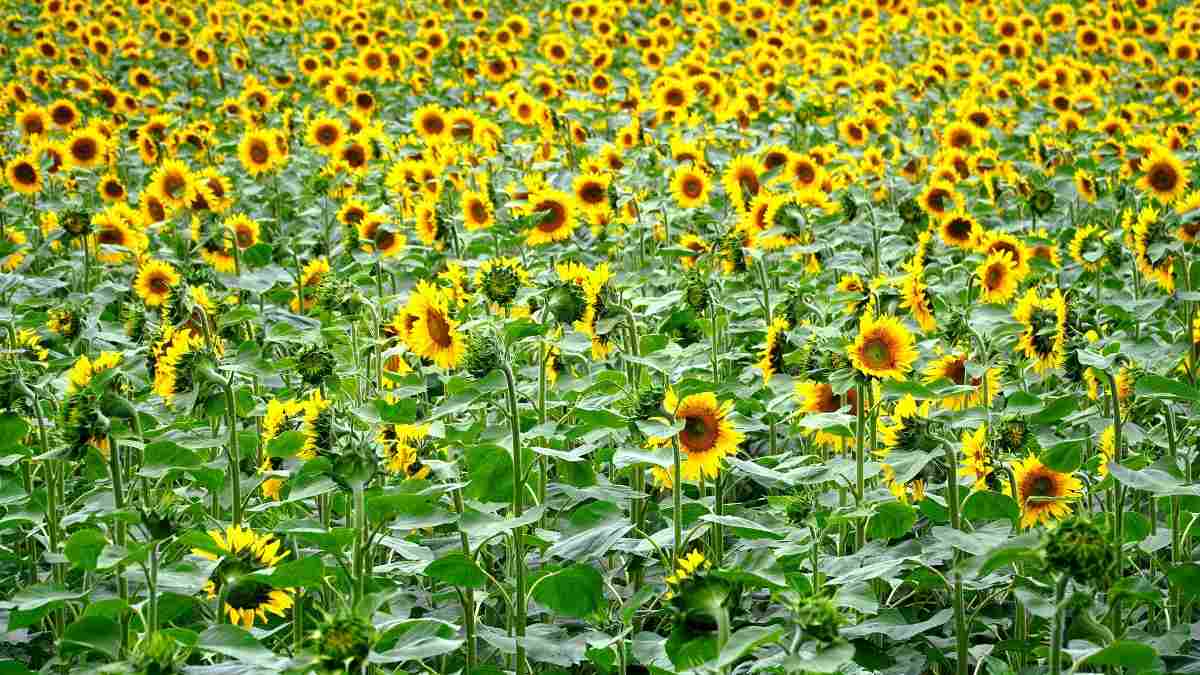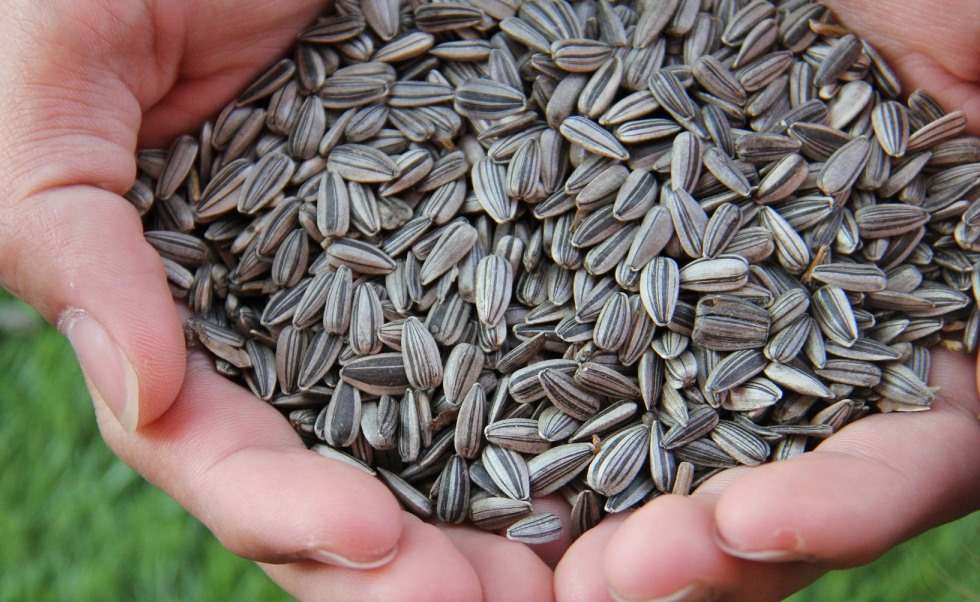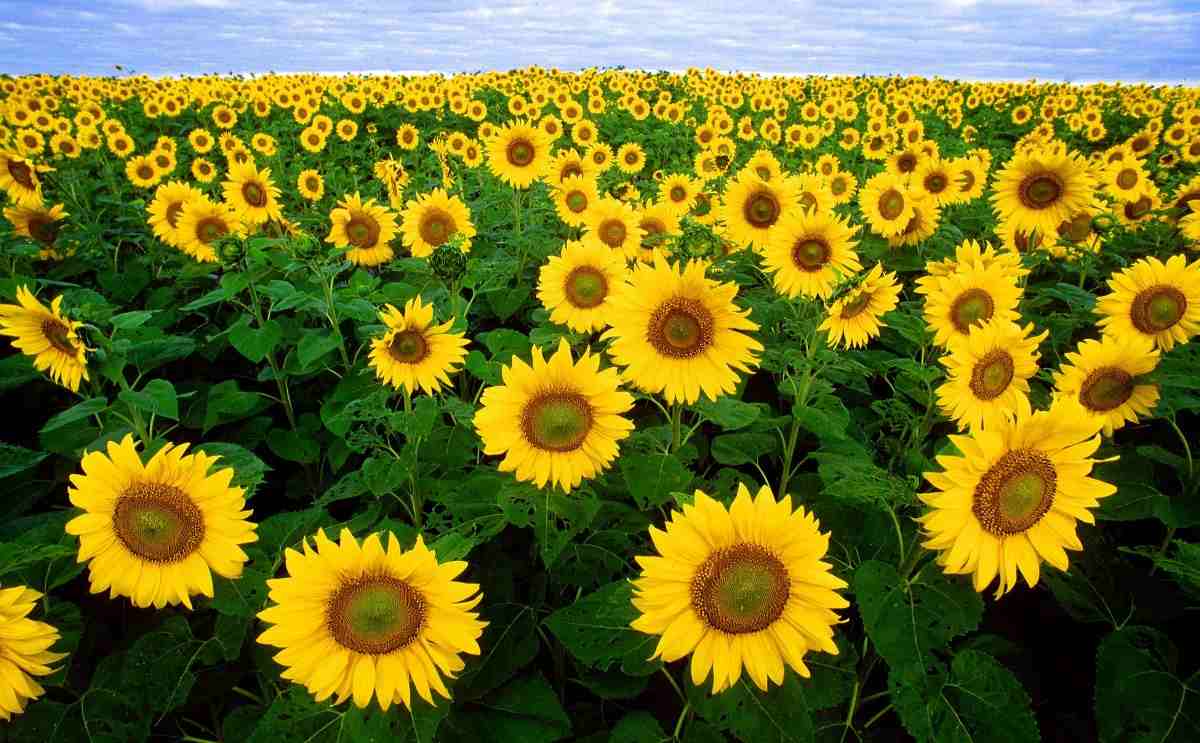Introduction to Organic Sunflower Production
Sunflower / Helianthus annuus belongs to the Asteraceae family and it is one of the fastest-growing oilseed crops in India. Sunflower is also known as Soorajmukhi, Suryakanti, Poddutirugudu, Curiyakanti, and Suryamukhi, etc. Sunflower plants are easy to grow because they’re heat tolerant, pest resistant, and also fast growing. Sunflowers look like giant daisies, with bright yellow (and sometimes red or brown) petals radiating from brown centers that ripen into a head filled with seed. Sunflower can give a large quantity of top quality oil per unit area and per unit time. In India, Sunflower has gained popularity due to the national priority of vegetable oil production. India is one of the largest producers of oilseed crops in the world and Sunflower is an important oilseed crop in India.
A Step by Step Guide to Organic Sunflower Production in India

There are many benefits to growing Sunflowers including their cut flowers and free edible seeds.
The features for the phenomenal growth of Sunflower in India are;
- Wide adaptability to a range of soil types and agro-climatic conditions
- Short duration (70-100 days)
- High yield potential of seed and oil
- High-quality edible oil
- High seed multiplication ratio (>1:80)
- It is easier and cheaper cultivation (low seed rate, no specialized operations, low water requirement)
- It contains 40 to 44% of good quality oil and a high amount of quality protein in cake
Sunflower seeds contain 46 to 52 % edible oil. Sunflower oil is healthy and popular for its light and odorless nature. It is rich in vitamin E. It is propagated through seeds. February to March is the best time for planting Sunflowers. It is grown in temperate regions. It is a major source of vegetable oil in India and the world. India is a leading producer of Sunflower oil-seed crops. The Sunflower oil that is manufactured from seeds is widely used in India for cooking purposes. The crop requires a cool climate to cultivate well and can tolerate frost during the seed germination stage. During the flowering stage, it requires a warm climate.
Organic Soil Preparation for Sunflower Production
Sunflowers grow best on well-drained, high water-holding capacity soils with a nearly neutral pH level (pH 6.5-7.5). The optimum soil classifications for Sunflower plants are loam, silty loam, and silty clay loam soils. Organic Sunflower production performance on reduced agricultural capacity soils such as those affected by salinity, drought potential or wetness, is not ideal but compares with other commonly grown commercial crops.
Crop Rotation for Organic Sunflower Production
Having a proper crop rotational sequence is important within Sunflower farming. The following points are the yield-reducing problems;
- Disease and disease-infested fields (e.g. increased sclerotinia)
- Increased insect risk
- Increased populations of certain weed species
- Increased populations of volunteer Sunflowers
- Soil moisture depletion
- Allelopathy or phytotoxicity of the Sunflower residue to the crop
Planting Site for Sunflower Farming;
- Find a sunny spot and grow best in locations with direct sunlight (6 to 8 hours per day) and they require long, hot summers to flower well.
- Choose a location with well-draining soil and it shouldn’t pool water after it rains.
- Sunflower plants aren’t picky but the soil can’t be too compact.
- Sunflowers thrive in slightly acidic to somewhat alkaline soil pH level 6.5 to 7.5.
- The plants are heavy feeders, so the soil needs to be nutrient-rich with organic matter or aged manure. Or, work in a slow-release granular fertilizer 8 inches deep into the soil.
- Larger plant varieties may become top-heavy and a strong wind can be devastating.
Spacing Requirements in Sunflower Farming
Sunflower should be sown 60 cm apart in lines with a plant to plant spacing of about 20 cm. The seeds should be sown 3 to 4 cm deep by corn planters in furrows. After 10 to 12 days of germination, extra seedlings must be uprooted to provide a space of 20 cm between plants in rows.
Seed Rate and Time of sowing in Organic Sunflower Production

To obtain good crop yield, complete the sowing of Sunflower by January end. In case of delay in sowing, use transplanting method as direct sowing cause reduction in crop yield also delay sowing causes high pest and disease incidence. Use a seed rate of 2-3 kg/acre for sowing. For hybrid use seed rate of 2-2.5kg/acre.
Planting Depth and Planting Techniques in Organic Sunflower Production
Sunflower seeds are planted at relatively shallow depth levels. In soil with high clay content, seeds are planted at a depth of about 25 mm. In sandy soils, Sunflower seeds can be planted at a depth of up to 50 mm. Plant Sunflower seeds should be able to space evenly; it has a good depth control mechanism. Though good contact between the seed and the soil is essential, for this purpose, the use of press wheels is necessary. Sunflowers are sensitive to compacted soil, which means that press wheels should exercise light pressure on the soil to avoid compaction during germination.
Sunflowers can grow to heights of about 8 feet or more and provide you with a large number of delicious seeds. Choose an area that gets plenty of suns, a minimum of 6 to 8 hours will be needed. Amend the soil with rich compost and organic fertilizers for planting a Sunflower.
Plant Sunflowers in the late spring season, once the ground is nice and warm. Most Sunflowers germinate when the soil has reached 21 to 29°C. The best time to plant Sunflowers is just before the soil reaches this temperature level. Look for a ground temperature of between 15 to 21°C. For most areas, this will be approximately 3 weeks after the last frost.
Different Sunflower plants require different planting depths and spacing. How to grow Sunflowers from the seed depends on the specific Sunflower cultivar. In general, plant Sunflower seeds at least 1/2 inch deep and space seeds 6 inches apart. If seeds planting in rows, you’ll want 2 to 3 feet between each row. These plants should be thinned out in a few weeks to the proper spacing. If soil temperatures are just right, seedlings will sprout up in 10 to 14 days.
Soil temperature needs to be at 10°C or more for your chosen soil depth about 1.5 to 2.5 inches. Planting Sunflower seed into cold soils may cause the seed to go into dormancy, resulting in delayed seed germination. If planting deeper than 2 inches, consider increasing planting population. Sunflowers should never be planted deeper than 2 inches. Good seed-to-soil contact is important in Sunflowers and makes sure soil is pressed firmly against the seed at planting and the furrow is closed following seed placement. Also, this is very important in all crops, but particularly for Sunflower. Poor seed-to-soil contact will result in uneven emergence. Row cleaners must be able to move residue away from the furrow to prevent hair pinning. With air drills, little can be done; wait for better conditions. Be willing to dig seeds to check placement for depth and proper plant spacing.
Conditions Required for Organic Sunflower Production
- Avoid extremely high-temperature levels during planting time, as well as the possibility of frost damage.
- The quantity of water that has been preserved in the soil before planting time has a major influence on the establishment, plant growth, and survival of the plants during droughts.
- Sunflowers must be planted in narrow rows (90 to 100 cm) in clay soils to improve soil water utilization.
- Sunflower plants grow best in spots that get 6 to 8 hours of direct sun per day.
- Sunflower plants prefer loose, and well-drained, somewhat alkaline soil with a pH level of 6.5 to 7.5.
- Sunflowers are heavy feeders, so the plants will be healthiest and generate the most blooms in nutrient-rich soil that has had compost or other organic matter mixed into it.
- Too little sunlight can retard Sunflower formation, which means no blooms on Sunflower plants. Nutrient-poor and sandy soil aren’t likely to produce generous blossoms.
- The speed of seed germination is dependent on three factors; soil temperature, moisture, and oxygen. The preferred soil temperatures for planting Sunflower are 10 to 12ºC. However, seed germination will occur as low as 4ºC.
- Sunflower plants grow best with the right weather conditions, and most types have very similar needs for healthy growth.
- When the plant is small, water the area around the plant roots, about 4 inches from the plants.
- Water deeply once the plant is established but infrequently to encourage the plant to grow deep plant roots. Water once a week with several gallons of water per plant, more often if the weather is dry or very hot.
Irrigation Requirements for Organic Sunflower Production
Irrigate immediately after sowing followed by irrigation on 4th – 5th day and later at intervals of 7 to 8 days according to soil and climatic conditions, seeding, flowering, and seed development stage. Generally, no irrigation is needed for the Kharif crop. Rabi crop may be irrigated thrice after 40, 75, and 110 days of seed sowing. This crop is highly sensitive to water stress between flowering and grain filling stages. Therefore, irrigation can be provided in case of moisture deficiency during this stage. The irrigation requirement of the Sunflower crop during summer is relatively higher. Among the many stages, bud initiation, flowering period, and seed development stages are critical stages in terms of irrigation.
Sunflowers belong to a group of drought-tolerant plants. As long as the plants receive enough water during establishment when they are developing their root system. Sunflower plants can withstand periods of drought and heat. Sunflower plants also withstand wet, humid weather, although well-draining soil or containers are essential in such climates. Sunflowers experience growth problems if they become water-logged.
Organic Nutrient Management in Sunflower Production
Organic systems are depleted of nitrogen, but soil sampling can help determine the need for supplemental nitrogen amendments. One strategy organic grower’s use is to grow an early maturing crop like barley or winter wheat, the year before Sunflowers, and grow a cover crop of a fast-growing annual legume directly after grain harvest.
Compost also can be used to great advantage for this crop. The compost comes from a reliable source, where the manure was brought to temperatures that kill weed seed. Well-made composts can be sampled and analyzed for nitrogen content so that a better estimate can be made of nitrogen release during the Sunflower growing year.
Compost also has substantial potassium, which might be limiting on very sandy soils, as well as sulfur. Sulfur fertilizers also used for Sunflower plants include gypsum from natural sources and potassium sulfate. Sunflower is susceptible to lodging and greater disease susceptibility when too much nitrogen is applied, so rates of estimated available nitrogen should be conservative and should not exceed 150 pounds of nitrogen per acre.
- Economical Aquaculture: A Guide to Low-Budget Fish Farming
- 15 Common Planting Errors That Can Doom Your Fruit Trees
- How to Make Houseplants Bushy: Effective Tips and Ideas
- Innovative Strategies for Boosting Coconut Pollination and Yield
- Pollination Strategies for Maximum Pumpkin Yield
- The Complete Guide to Chicken Fattening: Strategies for Maximum Growth
Organic Pests and Diseases Control in Sunflower Production
The most common Sunflower pests include the following;
Sunflower Beetles – These feed on the leaf foliage and in small numbers or older plants may seldom hurt the Sunflower plants. Though, on younger Sunflower plants, the first true leaves can be severely damaged or completely consumed.
Cutworms – Cutworms can damage the leaves of young Sunflowers like leaving notches or holes. Wilting may also occur. Again, these are not a major issue unless there is a heavy infestation.
Sunflower Moths – Sunflower moths are one of the most destructive pests to Sunflower plants, laying their eggs within the flowers. From the eggs hatch tiny, yellow worms that feed on florets and pollen. Older Sunflower moths are brown- or purple-striped with light brown heads, finally destroying the plants.
Pest controlling in Sunflower plants involves prevention. Keeping the planting area free of weeds and debris can help. Damage can also be reduced by treating the area before pests become well established. Later planting, such as in June or July, may help alleviate any problems. Several broad-spectrum insecticides available for Sunflower use, organic insecticides, which are deemed safer, can be used as well including Bt products.
While Sunflowers can be affected by some disease problems, rarely is this an issue, as these plants are typically quite hardy. Several leaf spot diseases may cause surface spots or yellow patches. Rust, verticillium wilt, and powdery mildew can also affect plants on occasion. Though, the most common threat to these plants is Sclerotinia stem rot, also known as white mould. This fungus can cause sudden wilting of plant leaves, stem cankers, and root or head rot. Crop rotation can reduce the likelihood of this plant disease as well as proper watering practices.
Organic Pest Control for Sunflowers is;
Sunflower plants are usually not affected by diseases and insects. However, several remedies can be tried to take care of pests on Sunflowers.
Dishwashing Soap – Mix 1 tablespoon of dishwashing soap with 1 gallon of water. After test spraying, a couple of leaves, spray on the whole plant for aphids, mites, mealybugs, and thrips.
Ammonia – This spray made with 1 part ammonia and 7 parts water helps to get rid of Sunflowers of bugs.
Vegetable Oil Spray – Mix 1 tablespoon of liquid dishwashing soap with 1 cup of vegetable oil. A variety of oils like safflower, peanut, sunflower, or soybean can be used. To control bugs like aphids, mealybugs, scales, and mites, take 2 grams of this mixture and mix with 1 cup water and use to spray the Sunflower plants.
Baking Soda Spray – Fungal diseases such as black spot and powdery mildew can be remedied by mixing 1 teaspoon of baking soda with one quart of warm water. Then, add a teaspoon of liquid dishwashing soap. Spray on Sunflower plants.
When and How to Harvest Sunflower
The Sunflower crop matures in 90 to 100 days. The crop has to be harvested when the lower side of the head turns yellow color and some of the bracts dry up. The mature Sunflower heads are cut with a sickle and are dried by exposing the upper side with seeds to the sun. The well-dried heads are beaten with sticks to separate the Sunflower seeds. The cleaned seed is dried well and then stored in gunny bags.
Commonly Asked Questions about Sunflower Farming
You should not miss this: Organic Ashwagandha Farming.

In which season does a Sunflower plant grow?
Sunflower seeds can be sown successfully from January to June for flowering during summer and the rainy season. At planting time, a light application of fertilizer will encourage strong root growth to protect them from blowing over in the wind.
Do Sunflowers need lots of water?
Sunflowers require sunny conditions to thrive and they need about an inch of water per week.
Do Sunflowers die after they bloom?
Sunflower plants grown as annuals die after producing their flower heads go to seed. The annuals are usually the varieties cultivated for their large size. A few types of Sunflowers can be grown as a perennial, which means they will grow more flowers again the next season.
What nutrients do Sunflowers need?
The major nutrient required by Sunflower plants is nitrogen and has the greatest impact on seed size, leaf size and several leaves, and yield.
How do you know Sunflower is dying?
A Sunflower will signal that it is dying with stunted growth followed with dropped leaves, and stem turning yellow, brown, or black, and the petals on the flower head shrivelling up.
Is Sunflower a cash crop?
Sunflower can be grown as a cash crop. It is used to make cooking oils, animal feeds and soaps. Sunflower crop will grow well where maize and beans are grown.
In case if you are interested in this: Sunflower Oil Production Business.